Young Hvar Locals Dissatisfied with New Vrboska Bridge and 'Headstrong' Mayor
February 27, 2022 - Young Hvar locals have expressed their dissatisfaction with the new Vrboska bridge and their 'headstrong' mayor, prompting a response from mayor Nikša Peronja.
Vrboska, a picturesque village within the Jelsa Municipality, located in a deep bay in the northern part of Hvar island, is in the spotlight after the local youth, dissatisfied with the appearance of the new bridge, told the public that they had enough of their headstrong mayor.
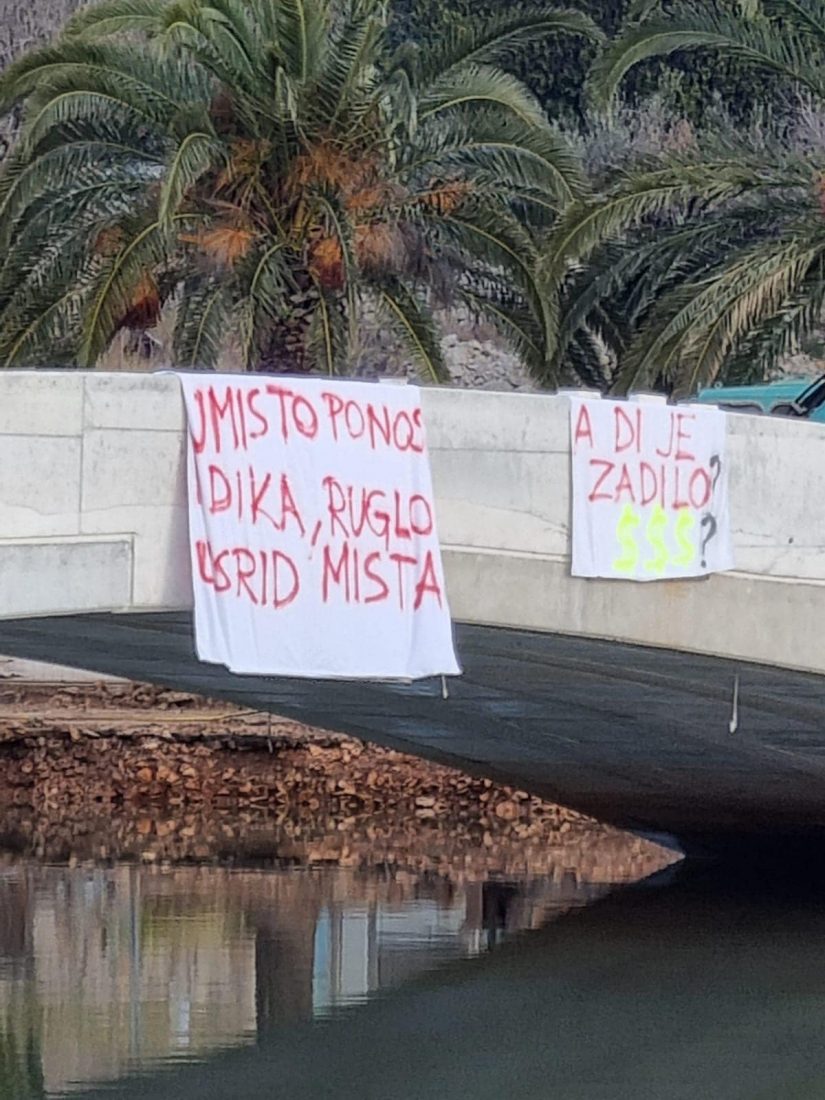
Reader
"The dissatisfaction of the people of Vrboska has been going on for some time; it is not from yesterday. This bridge is just a drop in the bucket," a 63-year-old resident said for Morksi.hr, noting that he would be happy to share the whole story, but it would then take us hours of conversation, and he doubts that the media coverage of all the real problems facing the people of Vrboska would change anything.
"Vrboska does not need a road bridge at all. It is in the shape of a horseshoe, and the road was built in the 1960s and leans on that horseshoe. So this bridge could easily have been the most common wooden pedestrian bridge, and not a bridge for road traffic," the local adds.

Reader
Morski learned that the price of the concrete bridge jumped from the original 1.8 to more than 4 million kuna. The bridge is almost a meter higher than the original project, selected by a seven-member jury five years ago, including SDP Jelsa mayor Nikša Peronja, who addressed the dissatisfied residents last week on his Facebook profile.
"The bridge will be completed approximately two weeks before Easter, and we have coordinated this with the contractor, designers, and all other participants in the project. I know that various stories and theories have appeared in Vrboska; most are completely unfounded and have no basis in reality. You must understand that it is the worst for me because I have objections, not the designer who had to change the project several times. We had a problem with mud at the bottom and even a problem with wells that did not show the correct condition of the soil. We encountered a whole series of problems, and the construction of the bridge took some time," said Peronja.
According to the mayor, the old bridge was statically defective and thus unsafe to use, so it was out of order. However, he is convinced that the locals of Vrboska will be satisfied in the end.
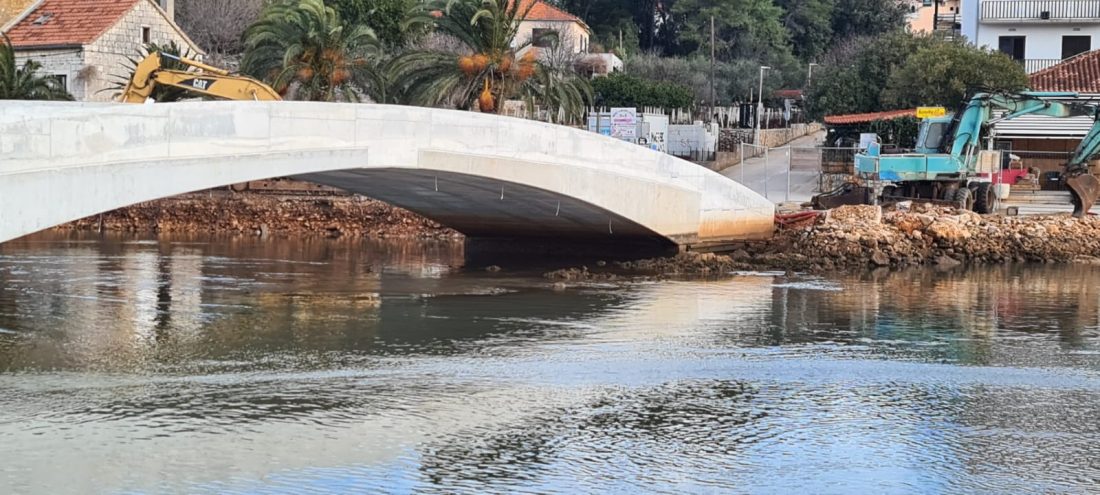
Reader
The locals of Vrboska say the municipality makes good money - both from the sale of land and from utilities. But some of them claim that little is being invested in this settlement with about 500 permanent residents who would like to get, for example, public transport and bus stops. In addition, the residents of Vrboska would like to get a new cemetery with a morgue, and the mayor promises that this wish will soon be fulfilled.
"You have to understand that when I came, there was almost nothing, we started from the beginning - we made changes and amendments to the Urban Plan, we bought land for the construction of the cemetery and morgue, we made all the necessary documentation and obtained a building permit. The paving of the cemetery remains, which will begin in about 15 days. And that should also be over by Easter," the mayor of Jelsa promised to Vrboska.
As for the morgue, it should also be completed by the end of this year, according to the mayor.
For more, check out our lifestyle section.
First Croatian Volunteers Arrive to Join the Ukrainian Army
February 26, 2022 - The fighting continues in Ukraine, and President Volodymyr Zelenskyy has made it clear that they will not lay down their arms. He also called for volunteers in Europe to join the defense of the country, and the first Croatian volunteers have reportedly arrived on Ukrainian soil.
Fighting has been going on in Ukraine for three days since Russia invaded to "carry out the demilitarization and denazification" of the neighboring country. And while Ukrainian forces are fighting fiercely in several cities, Croats will soon join them.
Today, the President of Ukraine Volodymyr Zelenskyy announced that they will not lay down their arms and the Ukrainian army will continue to contain the Russian invasion in Kyiv. Additionally, in a televised statement, he urged volunteers in Europe to join the fight, who would be given weapons.
The first Croatian volunteers are going to the battlefield in Ukraine to fight on the side of the Ukrainian army, Dnevnik Nova TV writes.
As they have reported, a larger group of volunteers should join the Ukrainian army in a few days, and they have military experience from before and are full of desire to help the Ukrainian army.
Croats are not the only ones who will help Ukraine. Numerous countries have announced they are sending weapons, but also financial aid. On the other hand, ordinary citizens have made it clear what they think of Russian President Vladimir Putin's decision to go to war.
Protests against the Russian invasion took place in many European cities this Saturday, especially many citizens at the protests in the countries bordering Russia. Solidarity with Ukraine has been expressed around the world. In Zagreb, hundreds demonstrated against the Russian aggression that has so far claimed the lives of nearly 4619 Ukrainians.
For more on the Ukraine crisis and Croatia, as well as breaking news, follow our news section.
Hundreds in Zagreb Rally to Send Messages of Peace, Support to Ukraine
ZAGREB, 26 Feb 2022 - Hundreds of people gathered in Zagreb's Zrinjevac park on Saturday to show support and solidarity with Ukraine and Ukrainians as part of a drive aimed at sending out anti-war messages and signalling Croatia's readiness to help Ukrainian refugees.
The drive called "Enough of wars - we want peace!" was organised by the Centre for Peace Studies (CMS) to enable everyone to share messages of peace, encouragement, empathy and solidarity with the people of Ukraine who has been attacked and dragged into a war, as well as with the protesters in Russia and around the world against regimes which create wars and violence, said Sandra Kasunić of CMS.
She said the turnout at Zrinjevac was a sign of unity in condemning war and destruction and their deep and long-lasting consequences.
The position of the CMS is that Croatia must make every effort, through diplomacy and the policy of dialogue, to prevent the violence from escalating further, guided by the principle of protecting people's lives and resolving the Ukraine conflict peacefully, Kasunić said.
If necessary, she added, the CMS will organise more drives "to continue to channel" anti-war messages.
Among those at Zrinjevac were representatives of the Green-Left Bloc, whose MP Sandra Benčić said that they wanted to show solidarity with the citizens of Ukraine and express readiness to receive refugees.
"The most important thing at the moment is that the international community ensure corridors for civilians, to pull them out of war zones and accommodate them in European Union countries, including Croatia," she said.
That's why the We Can! party, by supporting parliament's Declaration on Ukraine yesterday, moved an amendment under which Croatia will extend concrete help by receiving and accommodating refugees, Benčić added.
"The City of Zagreb has already taken measures and defined potential accommodation capacities, which will expand depending on the needs, just as the City of Bjelovar has done," she said, adding that Croatia is acting responsibility and with solidarity.
Benčić said she hoped the situation in Ukraine would not spill over to the wider region or become a global war, adding that one must keep that in mind and prevent it through diplomacy and sanctions against Russia.
She said the sanctions "should be much tougher and more direct so that they really force Putin to sit at the negotiating table." She said the extent of the war was not evident yet and that "we all hope this ends as soon as possible. We appeal to absolutely every international actor to create pressure... so that negotiations begin."
Participants in the rally carried messages which said "Stop the war, life has no price", "Let's unite against war", "Down with imperialism" and "No to war".
They were joined by Ukrainian citizens living in Zagreb who were draped in the Ukrainian flag, as well as representatives of the Croatian-Ukrainian Society.
The Ukrainians told the press they were sad and concerned about their relatives and friends in Ukraine, and thanked Croatia for the support shown so far with the message "The Ukrainian people does not surrender."
Ukrainians in Split protest against war
In Split, dozens of Ukrainians today protested against the war in Ukraine and called on everyone in Croatia to help their compatriots in the most difficult moments of their lives.
Some of those Ukrainians have been living in Split for a while, while several arrived just before Russia invaded their country.
This, the second protest in Split since the war in Ukraine began was again organised by the CVIT Association for Ukrainian Culture in Dalmatia.
The protesters carried the Ukrainian flag and banners calling for the war to stop. They said they would do everything to help Ukraine.
Viktorija Balan of CVIT said more Ukrainians were expected in Split in the days ahead, asking everyone who could receive them to do so.
Croatian, Slovenian Unions of Migrant Workers Sign Agreement
ZAGREB, 26 Feb 2022 - Ana Horvat was elected president of the Croatian union of migrant workers in Varaždin on Saturday and the union also signed an agreement with the Slovenian union of migrant workers.
Horvat replaced Franjo Lazar, who tendered an irrevocable resignation, telling the press that one of the reasons was his failure to solve one of the biggest problems of Croatian migrant workers, double taxation.
He said the union sent nine proposals to the Finance Ministry a month ago but "received no reply, yet we proposed how to solve that more easily, less painfully."
Lazar said the union was established to keep young families in Croatia. People will emigrate from border counties, notably in northwestern Croatia, as well as from Istria, if double taxation continues, he added.
He said "every county interprets the double taxation agreement differently."
Asked if the government's incentive of HRK 200,000 could motivate Croatians working abroad to return to Croatia, Lazar said it could not and that in Austria they could make that in net pay in ten months.
The union's new president said Slovenians working abroad had similar problems and that this was why an agreement was signed with their union.
"They have managed to solve parts of that. We are continuing, we are not giving up and are working to achieve the best conditions possible for the people who work abroad," said Horvat.
The Slovenian union was established in 2016, its president Mario Fekonja said, adding that by working together the two unions will be able to show Europe the extent of their problems more easily.
"One of the fundamental postulates of the European Union is the free flow of labour and capital, which the financial administrations of Slovenia and Croatia, with their behaviour, deny us," he said, adding that both "operate illegally and arbitrarily."
Our priority is for all tax offices at national level to act equally and in line with the law, Fekonja said.
Croatian Traditional Jewellery: Coral, Silver and Gold in Dalmatia
February 26th, 2022 - Following our feature dedicated to traditional jewellery of Istria, a look at the intricate filigree pieces traditionally worn in Dalmatia
In the first part of this series, we wrote about medieval jewellery discovered in Istria that has only recently seen a revival in the form of artisan replicas.
The traditional jewellery of Dalmatia, however, has historically been an integral part of folk costumes all over the region, and has been worn and treasured by generations of women up to the present day.
Let's take a look at some of the most prominent designs found in Dalmatia:
Pag beaded necklace and earrings / Paški peružini i ročini
First, a quick disclaimer: depending on who you ask, Pag island is a part of Kvarner, Dalmatia, neither, or both. We'll leave the people of Pag to define their cultural identity as they see fit, and will include the island in this particular feature based on the shared traits of traditional jewellery of Pag and that found in the rest of Dalmatia.
The traditional costume of Pag island largely owes its distinctive appearance to the triangular headdress worn by women, made of starched white linen and lined with intricate lace.
The Pag lace is a showstopper, but if you take a closer look, you’ll see that the ladies are also adorned in jewellery when clad in traditional garb. It’s been worn on Pag since the 16th century, and considering that there were no master goldsmiths living on the island at the time, the jewellery was imported from Venice.
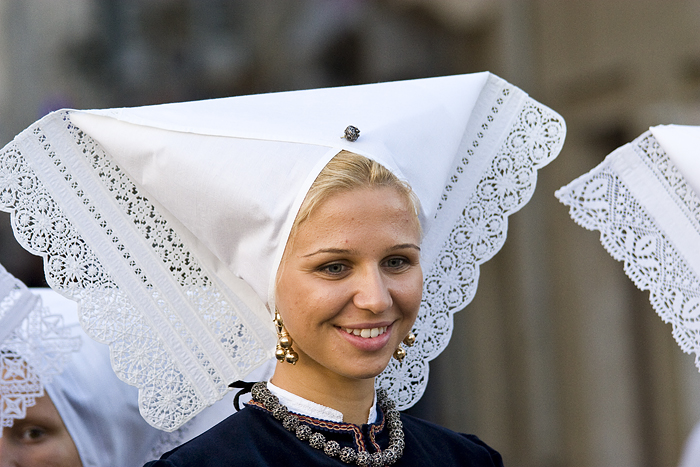 Pag folk costume / Image by Hotel Biser
Pag folk costume / Image by Hotel Biser
There are two distinct types of jewellery worn as part of the Pag folk costume. Delicate beads made in the filigree technique are called peružin; string a number of them together and you get a gorgeous necklace. Decorative hair pins featuring a single peružin were used to help keep the headdress in place, as seen on the above photo. It should be mentioned that the traditional peružini were once made to weigh exactly 123 grams each!
 A modern replica of Pag peružini / Image by Zlatarnica Jozef Gjoni
A modern replica of Pag peružini / Image by Zlatarnica Jozef Gjoni
The other distinctive piece found on Pag are the ročini, dangly bell-shaped earrings typically made of silver or gold.
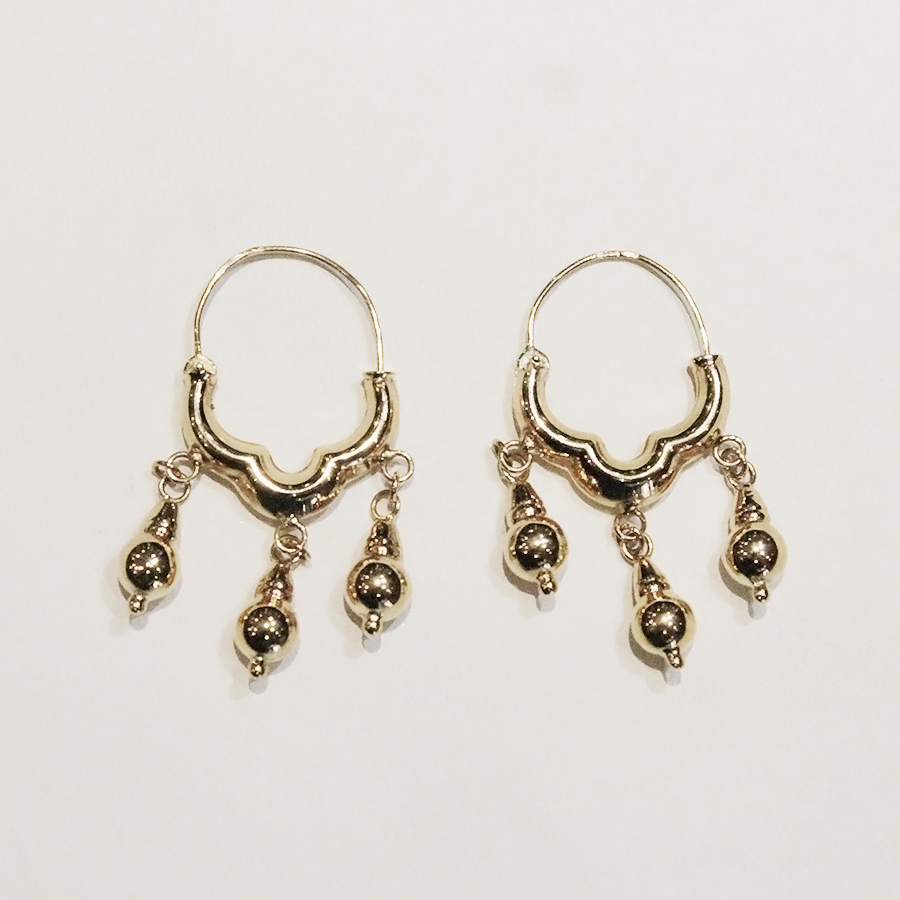 A modern replica of Pag ročini / Image by Zlatarnica Jozef Gjoni
A modern replica of Pag ročini / Image by Zlatarnica Jozef Gjoni
Šibenik button / Šibenski botun
Arguably the most popular piece on this list, the intricate Šibenik button used to be a decorative part of men’s folk costumes. These days, it’s one of the most recognisable symbols of Šibenik that doubles as an authentic souvenir. And while the motif is still seen in men’s accessories - tie clips, cufflinks - it’s not exclusive to gents anymore and is featured in women’s jewellery as well.
Similar to the Pag peružin, the Šibenik button is a hollow filigree bead composed of two half-spheres bonded together. Traditionally, the button used to be made of silver, but nowadays you’ll also find modern replicas made of gold, rose gold and aluminum. It's also called puce and toka, and was known to come in different sizes and designs depending on intended use.
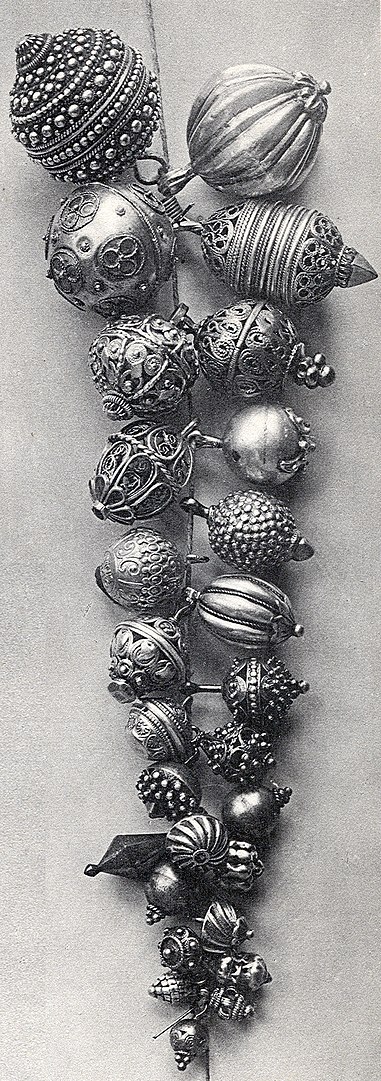 Various versions of Šibenik buttons
Various versions of Šibenik buttons
Even though there are metal buttons discovered in Dalmatia that date back to ancient times, the famous decorative bead only became widely adopted as a part of traditional garb around the 17th century.
As mentioned, they were only worn by men back then and were an indicator of social status and rank. The buttons were essentially comparable to military medals, as they were awarded to heroes and commanding officers from the region by Venetian generals based in Zadar.
Over time, the Šibenik button became so popular that a large number of artisans, from northern Dalmatia all the way to Albania in the south, specialised in the filigree technique so that they could create the intricate orbs.
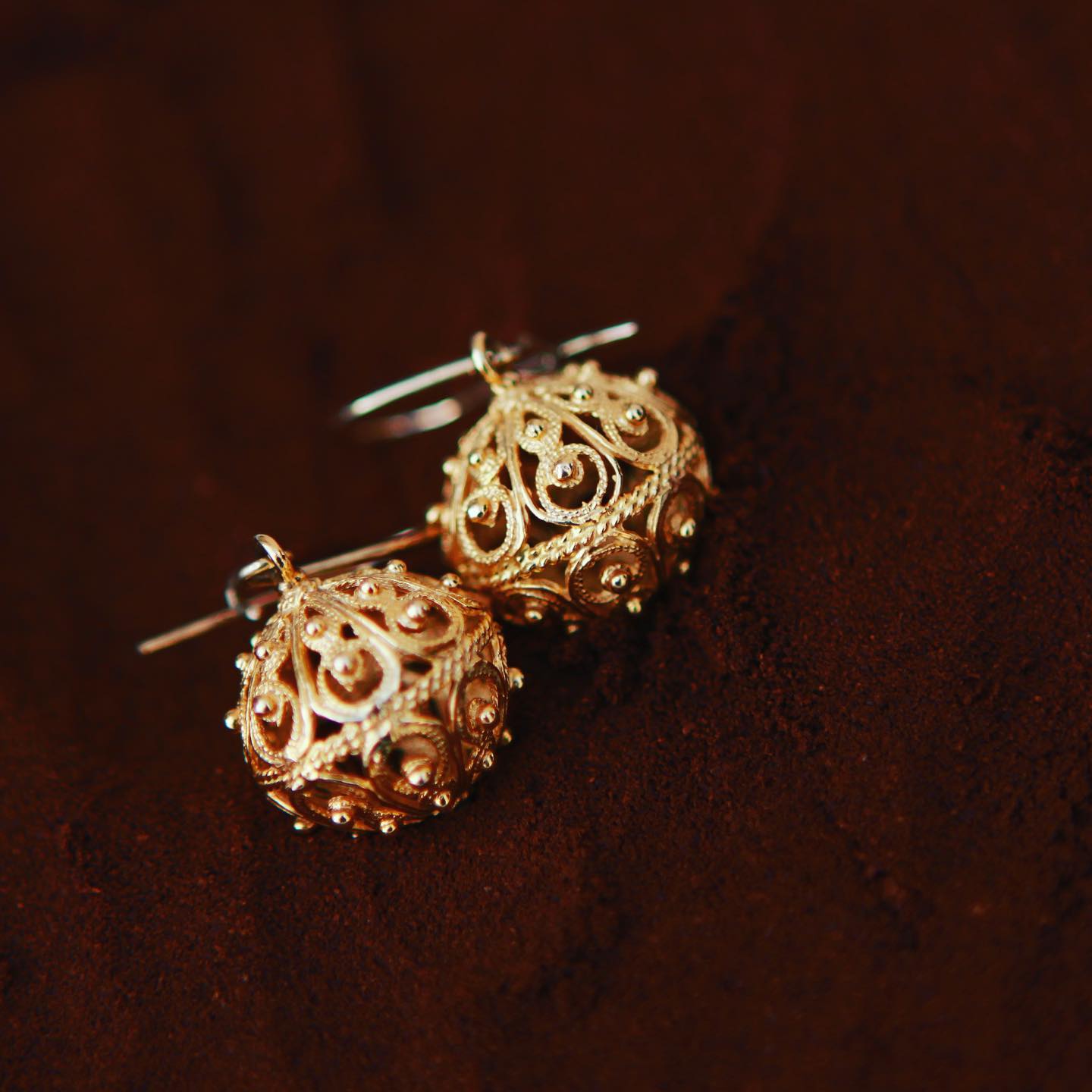
Šibenik button earrings / Image by Zlatarnice Rodić Facebook
Zlarin coral / Zlarinski koralji
For a little intermezzo on our filigree-laden tour, we’re heading to Zlarin island right off the coast of Šibenik, historically known for quite a specific thing: coral.
People of Zlarin have dealt in coral harvesting and processing since the 14th century; while harvesting isn’t that common anymore, Zlarin is still home to a handful of skilled artisans creating unique coral jewellery.
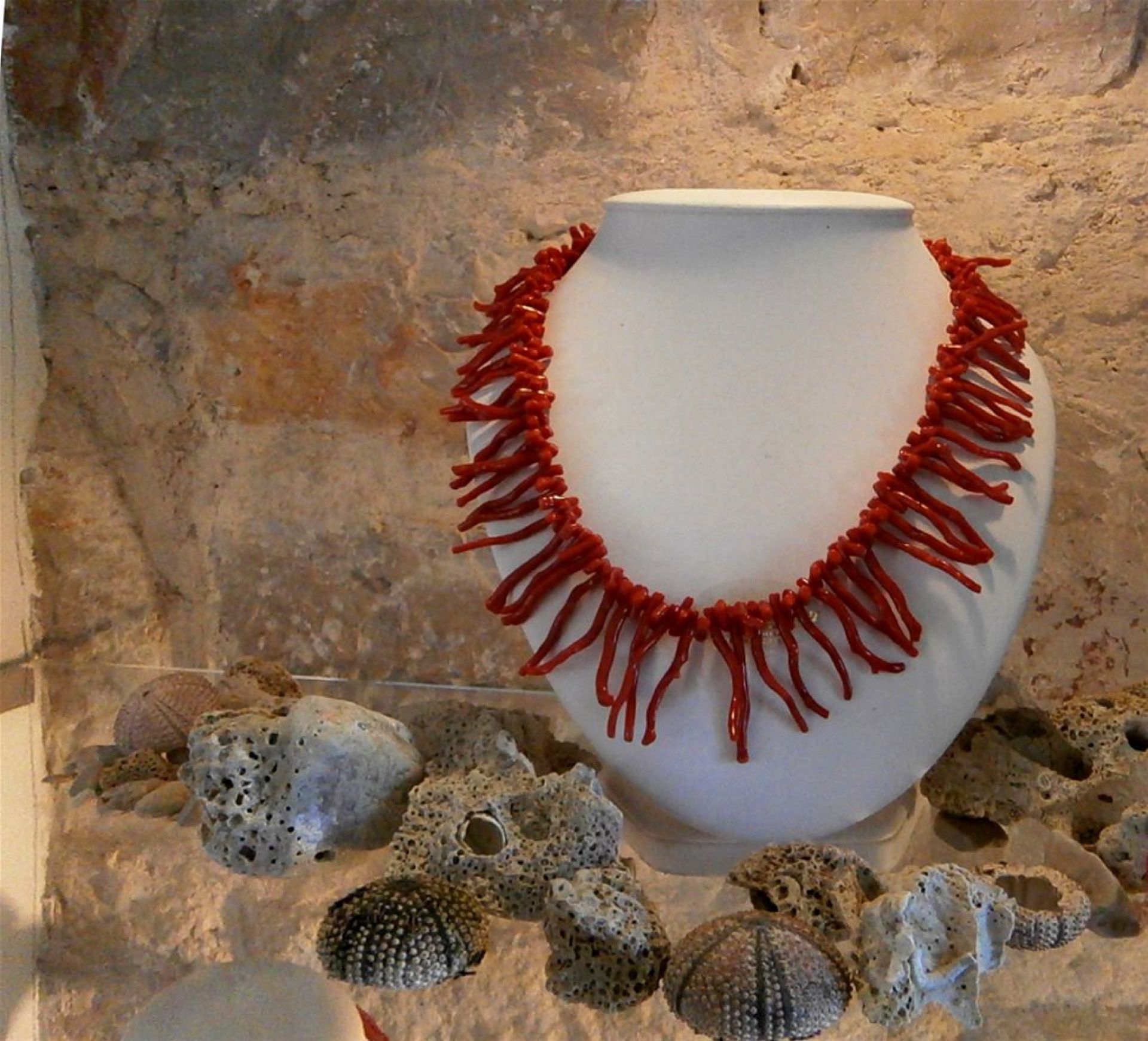 Red coral necklace / Šibenik Tourist Board
Red coral necklace / Šibenik Tourist Board
Red coral, also called precious coral, thrives in clean waters and grows at the depth of 30 to 200 metres. In its natural state, it’s covered in a crust that needs to be filed down for its intense red colour to show; the skeleton is then cut into smaller pieces, each of which gets filed, shaped and polished. Polishing is the most crucial stage, a process that can last up to a few days and results in a high shine. The colour has a range of 10-15 hues, varying from a light to a deep red.
The art of coral harvesting was a skill passed from father to son. Coral was historically harvested by trawling, using a tool called inženj, a wooden cross weighed down with a heavy stone and fitted with fishing nets. Coral would get entangled in the nets as they dragged across the seabed and break off when the nets were pulled out of the sea.
Fishermen from Zlarin participated in harvesting expeditions all over the Adriatic - sometimes straying even further, as far as Greece - and sold the catch on Sicily.
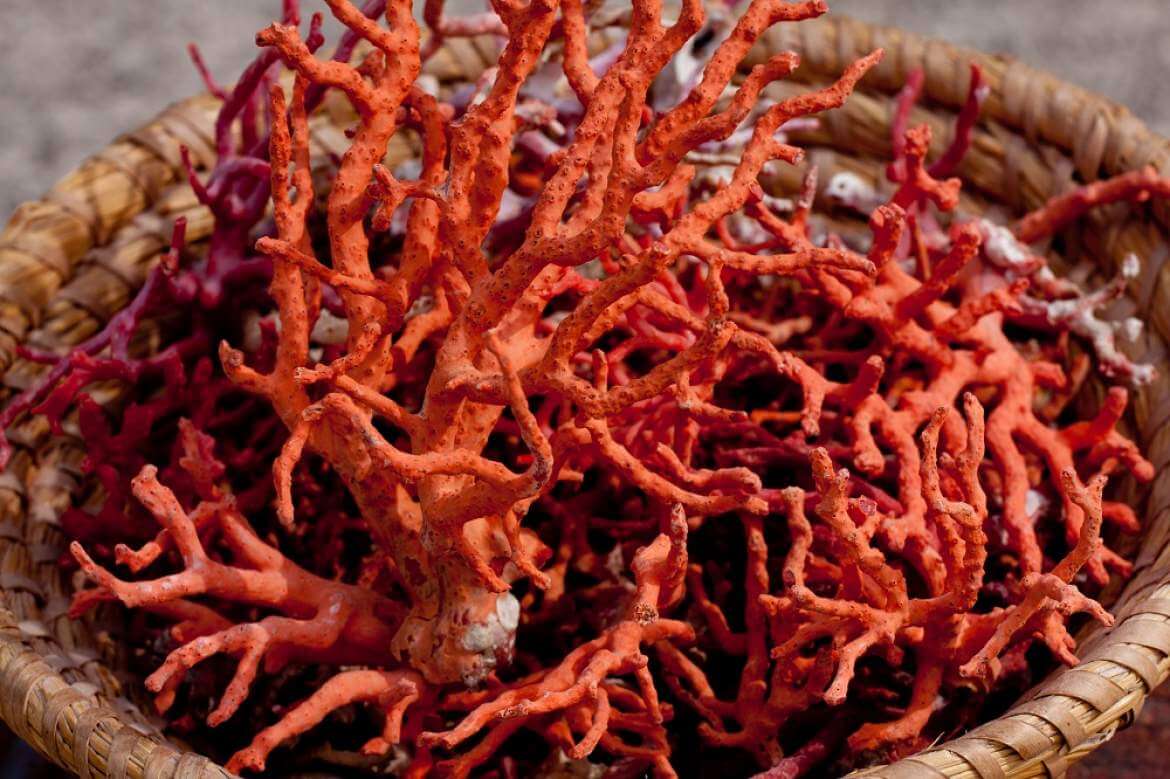 Red coral / Zlarin Tourist Board
Red coral / Zlarin Tourist Board
After the fall of the Venetian Republic that controlled the coral trade in the Adriatic, the people of Zlarin were granted the exclusive right to coral fishery. Like elsewhere in the Mediterranean, coral was overharvested due to its value until it was nearly eradicated, and so the practice gradually became less common by the mid-20th century.
Nowadays, the island is home to two coral shops run by jewellery makers that keep the tradition alive. Zlarin is also about to get a Croatian Coral Centre, a state-of-the-art facility dedicated to the island’s history of coral harvesting that's set to open sometime soon.
Konavle earrings / Konavoske verižice & fjočice
We’re heading further south, to the Konavle area near Dubrovnik, the home of the elegant Konavle earrings.
The verižice hoop earrings from Konavle have a small pendant, typically a pearl or a coral bead. In the olden days, there was a social order to wearing jewellery in Konavle: young girls wore smaller earrings, and the older the women got, the bigger earrings they could wear. Young men were known to present their brides with the lovely hoops as a gift before their wedding day.
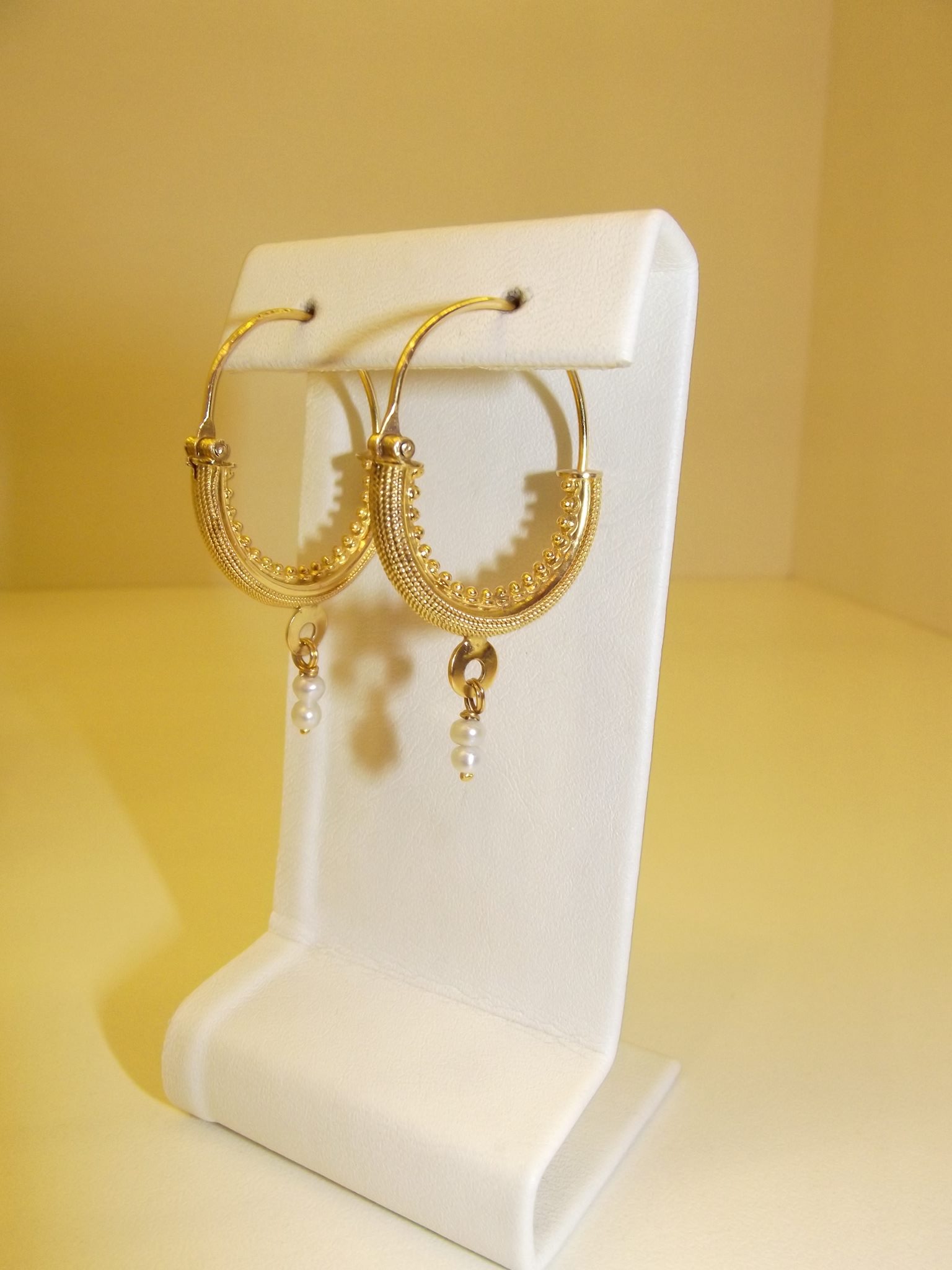 Modern replica of Konavle earrings / Image by Zlatarnice Rodic Facebook
Modern replica of Konavle earrings / Image by Zlatarnice Rodic Facebook
Traditional jewellery was handled with care and kept in decorative wooden boxes or in special compartments in chests. The best pieces were only worn in rare special occasions, as jewellery was considered a family heirloom and was passed down from generation to generation.
Another type of earrings popular in Konavle are the so-called fjočice. Worn by brides on the day of their wedding and in the first year of marriage, the dangly earrings had several pendants made in gold filigree.
The Croatian Post paid homage to the lovely fjočice with their own postage stamp, created by designer Alenka Lalić from Zagreb:

Interestingly, the Konavle earrings weren’t actually made in the Konavle area, but were instead manufactured by goldsmiths in Dubrovnik. In the 19th and 20th centuries, the goldsmith workshops predominantly focused on traditional jewellery, driven by the increasing demand from Konavle and the wider Dubrovnik area.
Dubrovnik necklace / Dubrovačke peružine & kolarin
As Dubrovnik used to be a major goldsmithry centre from the medieval times to the mid-20th century, it doesn’t come as a surprise that the Pearl of the Adriatic has its own type of traditional jewellery.
You’ll surely recognise the peružin motif by now, the hollow filigree beads which in Dubrovnik were traditionally made of gold. Strung together, the beads make a lavish necklace called kolarin.
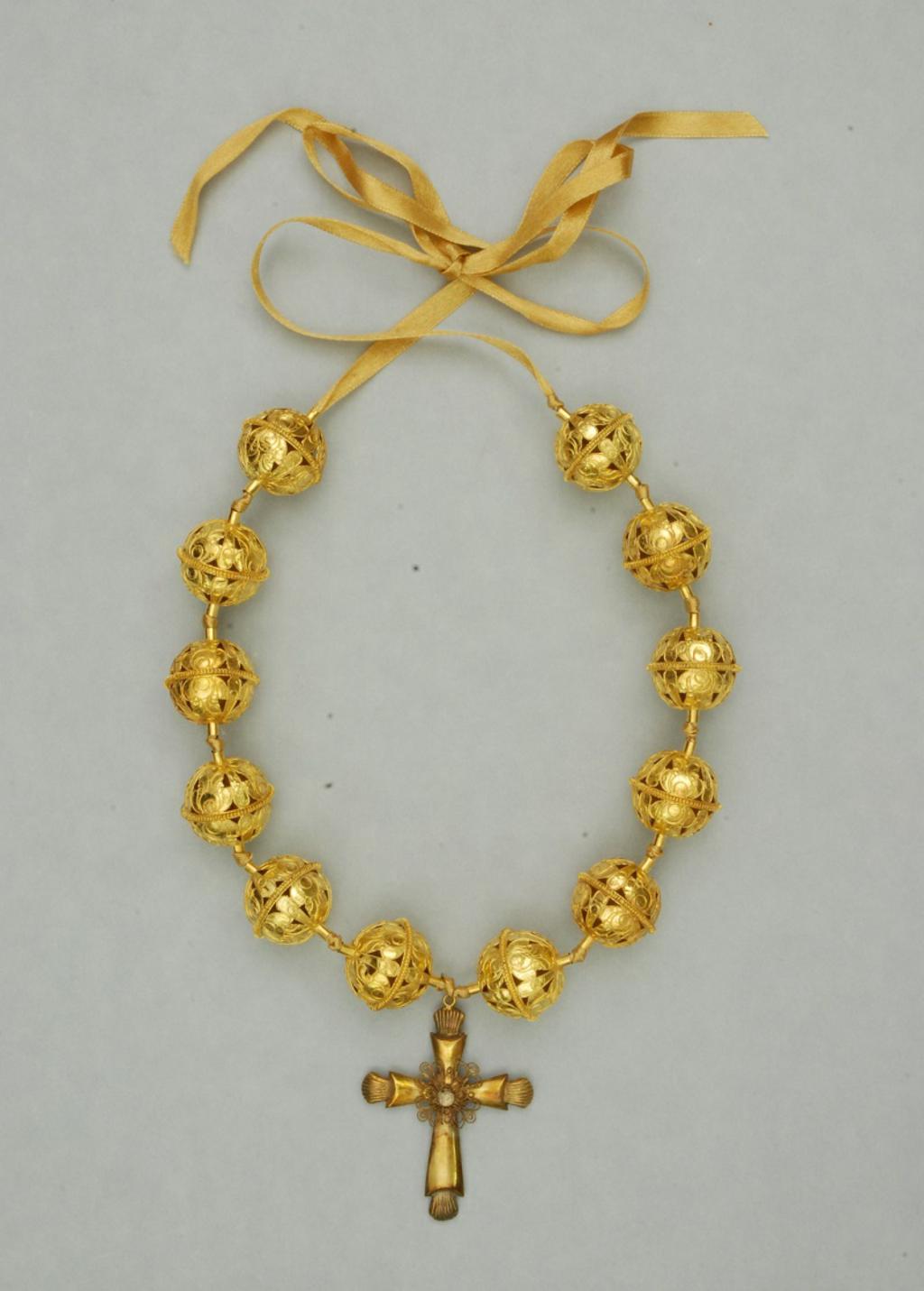
The kolarin were most commonly composed of 12, 14, 16 or 18 peružin beads, either simply strung on a silk ribbon, or connected with small golden links, pearls or coral beads. They were known to feature a heart-shaped pendant or a golden cross, altogether making a show-stopping piece typically worn on special occasions.
Nowadays, you'll most commonly find earrings or pendants featuring the Dubrovnik peružin bead.
Croatian Reporters Take 5 Ukrainian Children in Their Van En Route to Poland
ZAGREB, 26 Feb 2022 - Croatian reporters waiting in a long line at a Ukrainian border crossing to enter Poland on Saturday took five Ukrainian children in their van so they could meet with their mother on the Polish side of the border.
"There are many families with children. We, too, have taken five children in our van and will try to drive them to the border crossing. The police asked us to. The children's mother is on the other side of the border, in Poland," N1 television reporter Ana Mlinarić said in a broadcast.
Croatian reporters are waiting to leave Ukraine in a kilometres-long line near a border crossing with Poland. Mlinarić tweeted that thousands of Ukrainians are trying to leave the country, fleeing from war.
N1 reporters are sharing the van with crews from RTL and Nova TV who left Kyiv yesterday.
Croatia Can Receive Up to 17,000 Ukraine Refugees, Official Says
ZAGREB, 26 Feb 2022 - Croatia can provide for 3,500 persons from Ukraine at the moment and plans are being made so that up to 17,000 can be accommodated, Davor Spevec of the Civil Protection Directorate said in Slavonski Brod on Saturday.
The first six persons from Ukraine arrived in Croatia yesterday and they did not need the assistance of public services as they had private accommodation, he said.
"We have plans and places. They are hotels, hostels, dormitories... throughout Croatia," Spevec said, adding that if necessary bigger accommodation capacity will be provided.
He was in Slavonski Brod to attend a ceremony marking European 112 Day, International Civil Protection Day and Croatian Civil Protection Day.
Retiring in Croatia as a Non-EU National: A Cost-of-Living Comparison
26 February 2022 - In addition to its beautiful architecture and stunning landscape, a key draw for retirees looking to relocate to Croatia’s shores is a lower cost of living, especially for those coming from non-EU countries like the United Kingdom (UK) and America.
So far, we’ve discussed how to relocate to Croatia, and the cost of both public and private healthcare. Today, I present one of the more everyday aspects of the cost of living for retirees by examining the average prices of groceries.
I also draw comparisons across the top 3 most populated cities in Croatia, the UK, America, Canada, Australia.
- United States: New York, LA, Austin
- Australia: Melbourne, Sydney, Brisbane
- Canada: Toronto, Montreal, Calgary
- Croatia: Zagreb, Split, Rijeka
- UK: London, Birmingham, Glasgow
According to the Croatian Bureau of Statistics (DZS), over the last 5 years, these countries represent a significant proportion of non-EU citizens that choose to live out their retirement in Croatia.
Here’s a quick overview of the results:
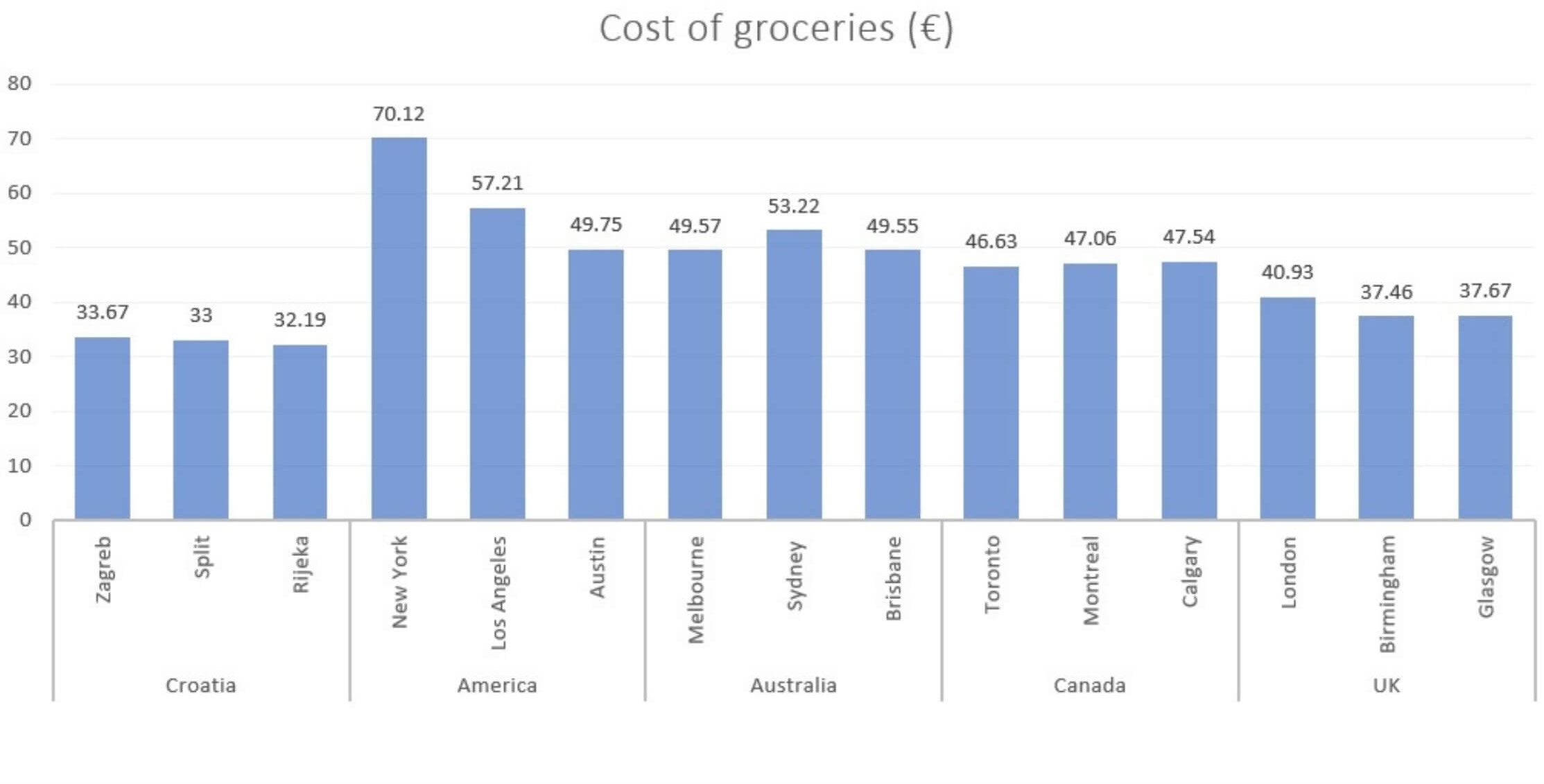
A couple of brief notes before we do a deeper dive into these figures.
Unlike the other 4 countries, produce you find in farmers' markets or even major supermarkets in Croatia (e.g. Konzum, Ribola) tend to be more seasonal. Generally, you will be able to find year-round items such as apples, bananas, and cucumbers, other items such as beets and watermelon tend to be stocked only when they are in season, though this trend is quickly changing with the rapid rise of tourism.
The listed items also reflect a sample of groceries that a household might purchase, they are not recommendations about how much you should spend or what you should be spending it on. Food spending varies from one household to another based on a multitude of factors like income, the type of food you buy, and other factors.
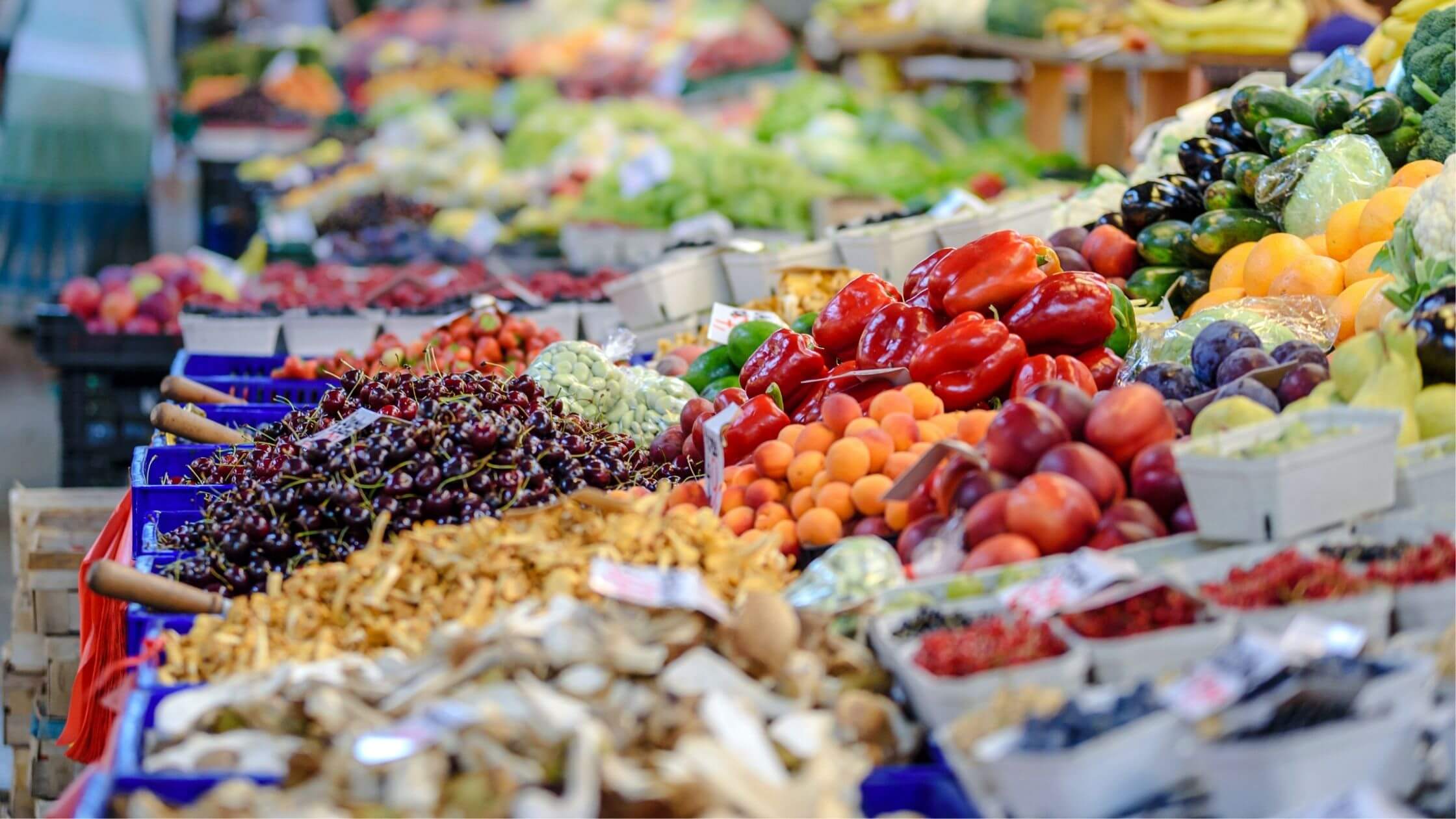
Image: Pexels.
Relative costs of grocery spend
While grocery prices in Croatia are indeed cheaper, wages in Croatia are also significantly lower than in these comparative countries on the list. The average monthly wage of a Croatian employee before taxes stands at €1,265 as of 2021, compared to €5,643 in New York.
Thus, with this sample grocery trip, a Croatian living in Zagreb spends an average of 2.67% of their income, compared to 1.24% for a New Yorker. In Calgary, the average pre-tax monthly income is €3,257 and this grocery trip cost 1.46% of that income, while in Birmingham, where average monthly wages are €2,232, these groceries make up 1.68%.
This means that the relative cost of groceries for a Croatian employee is significantly higher compared to these countries due to wage disparities.
Food trends during the pandemic
Finally, the COVID pandemic requires the acknowledgment of two key trends that impacted household grocery spending between 2020-2022, which are not accurately reflected in this sample.
The first is that food at home expenditures (e.g., grocery spending) rose during this time, while food away from home expenditures decreased due to lockdowns and mandates such as work from home. Second, global Consumer Price Indexes reflect a dramatic increase in household inflation due to supply chain disruptions, poor growing conditions, and overall economic uncertainty.

Image: Pexels.
In the years 2021-2022, the UK Office for National Statistics reports that food prices are up 4.5%. In North America, the Bureau of Labor Statistics highlights that grocery prices are up 7.4%, while Statistics Canada shows that consumers are paying 5.7% more for food. Australia appears to be bucking this trend and although the Australian Bureau of Statistics reports consumer prices have risen by 3.5%, prices for food and non-alcoholic beverages increased by a modest 1.9%.
Croatia saw a vast 9.4% increase in food and non-alcoholic beverages. However, this remains on par with other EU countries such as the Czech Republic which saw a jump of 8.8%, and Estonia with an 11% increase in food prices.
Grocery prices
Now let’s delve into the cost of groceries starting with the 3 most populated cities in Croatia. All estimates were taken from the average prices at Numeo and Price World.
Croatia
In terms of food production, the World Bank highlights that Croatia is self-sufficient in the production of wheat, corn, poultry, eggs, seafood, and wine, but a big importer of pork, beef, and surprisingly, pet food.
The first pet food manufacturing plant was only established in 2019 in Virovitica, to capture part of the €118.5 million pet food market which is now dominated by German and Italian facilities.
1€ = 7.54 hrk
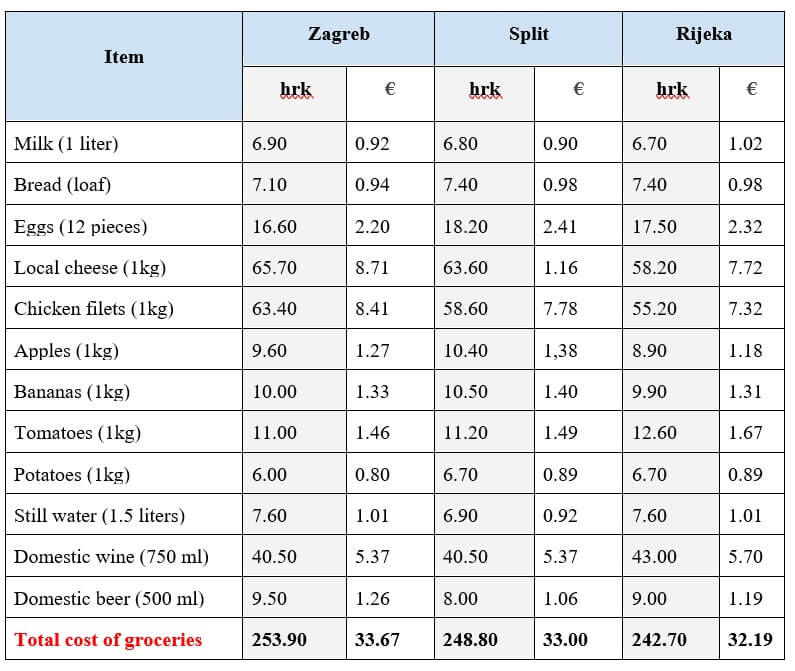
United States
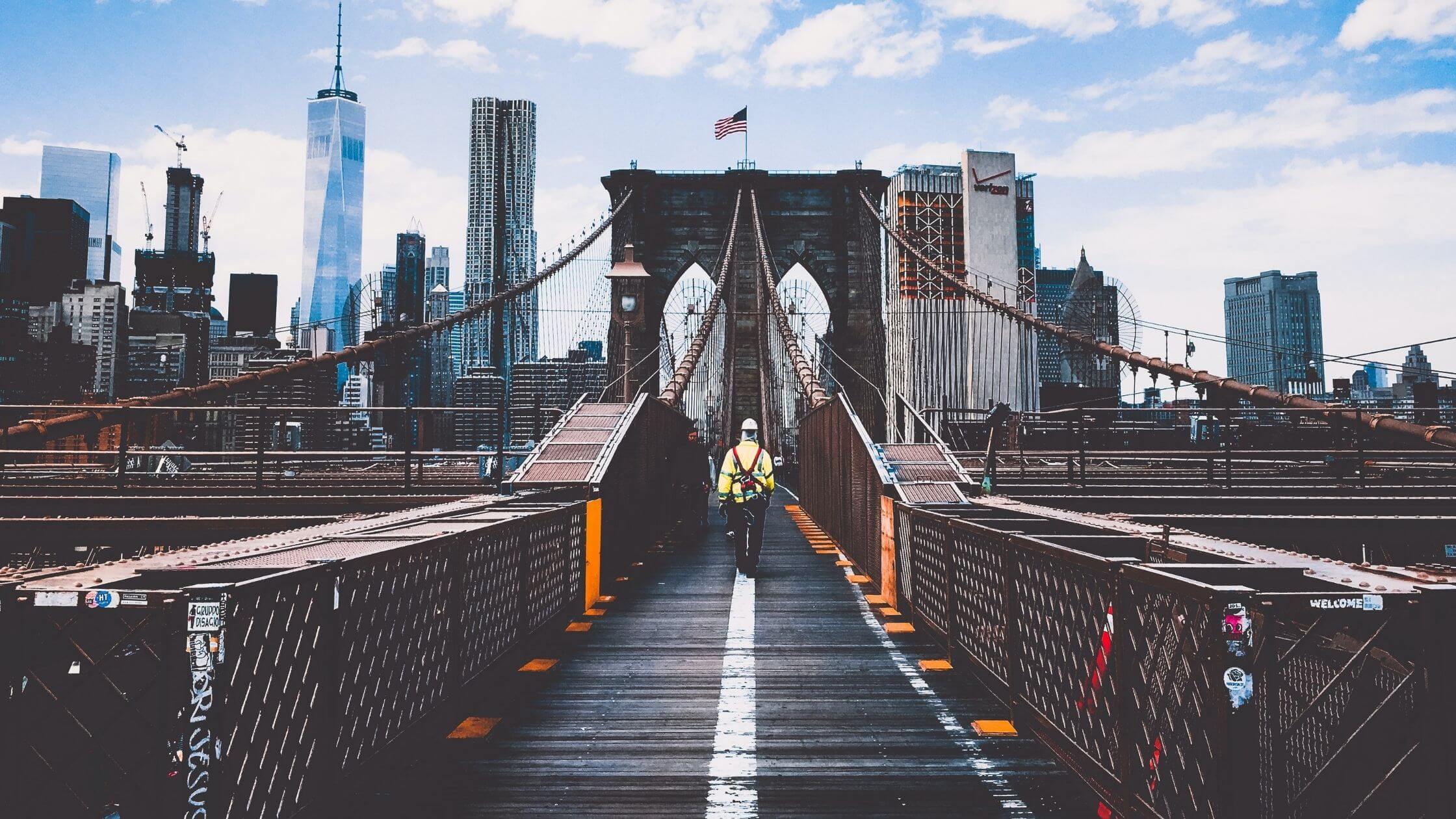
Brooklyn bridge, New York. Image: Pexels.
In 2021, meat and fish prices rose most sharply with beef and veal prices increasing by 9.3%, pork by 8.6%, and fish and seafood prices by 5.4%. With these increases, Customer Expenditure Surveys by the Bureau of Labor and Statistics show that the average grocery spend per month for a household (between 1-3 people) is: $401.75/€53 in New York, $378.59/€04 in LA and $393.75/€45 for Houston
(1€ = USD$1.13)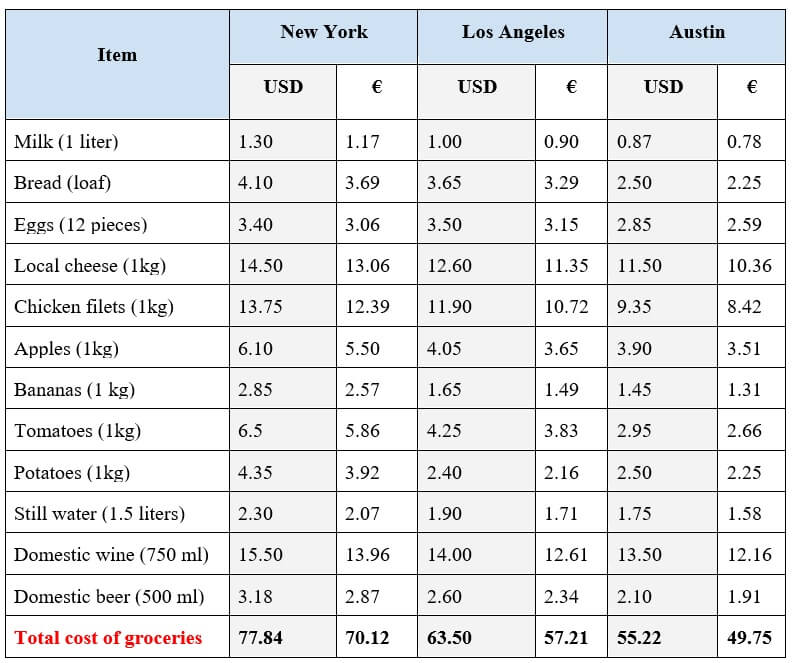
UK
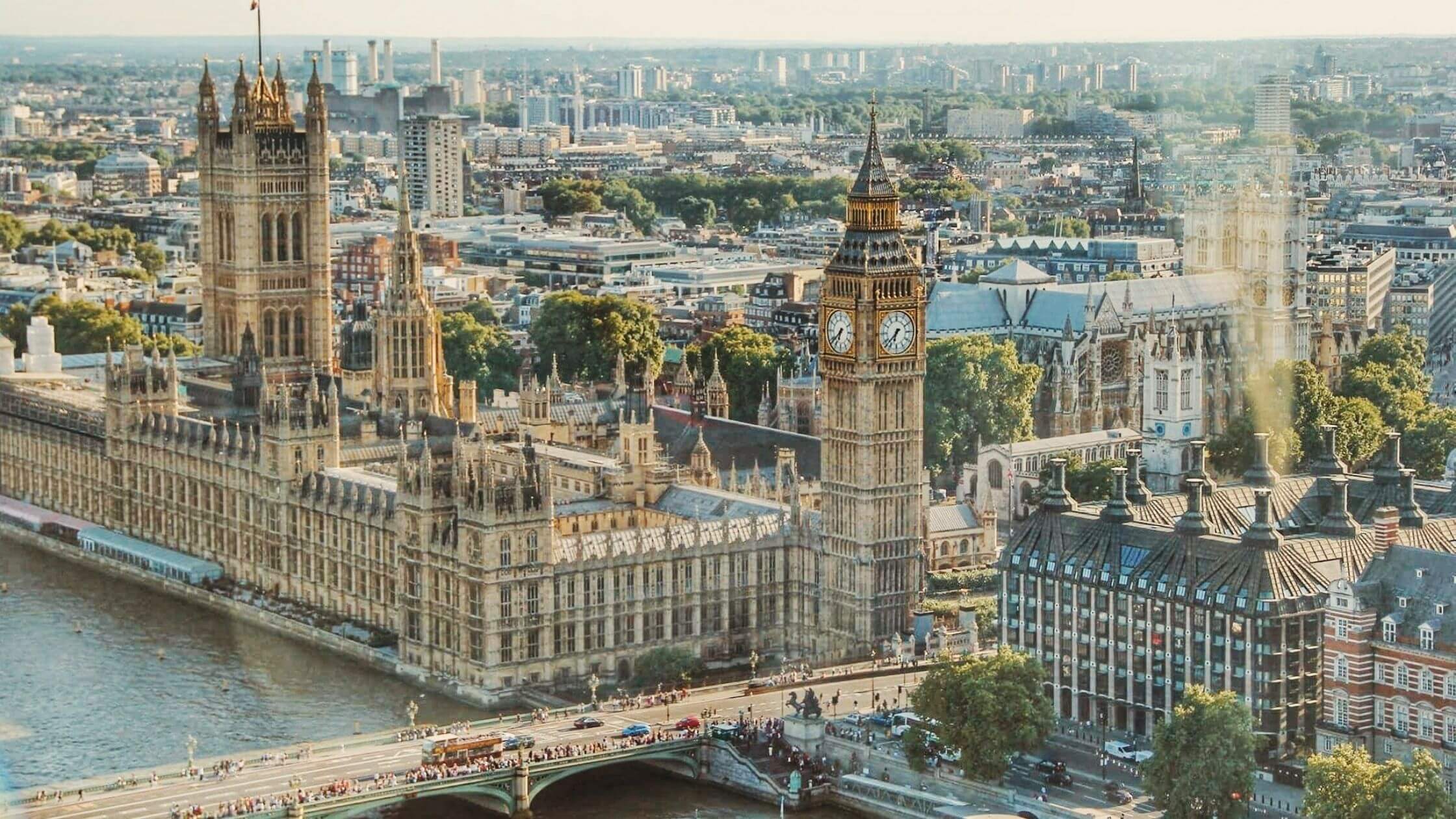
London, United Kingdom. Image: Pexels.
The Office for National Statistics revealed that the average food cost for a 2 member adult UK household in 2020 was £228/month (€261) or £57 (€65.55) weekly. In the past year, prices for fresh or frozen beef have risen 13%, while poultry is now 9.0% higher. Oils and condiments such as margarine and butter are also up between 12-16% over this time.
(1€ = £0.84)
Canada
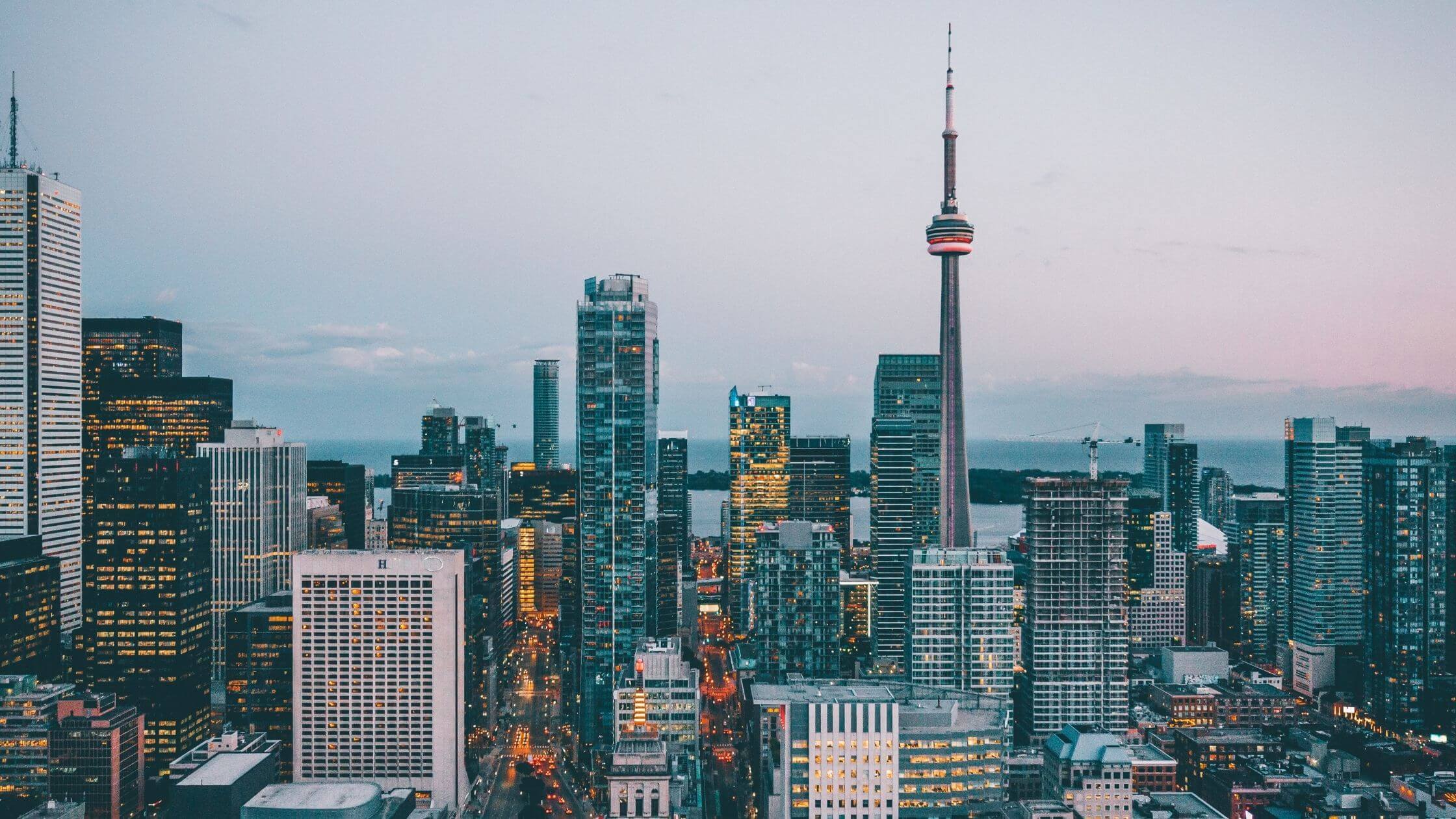
The CN Tower, Toronto. Image: Pexels.
The 2022 Canada’s Food Price Report predicts the average grocery bill for a family of 2 this year will amount to $7690.35 (€5,378) annually. This translates into $640.86 (€448.15) per month or $160 (€111.90) per week.
A significant increase in prices by 5-7% is also expected to affect dairy, vegetables, and bakery products this year.
(1€ = CAD$1.43)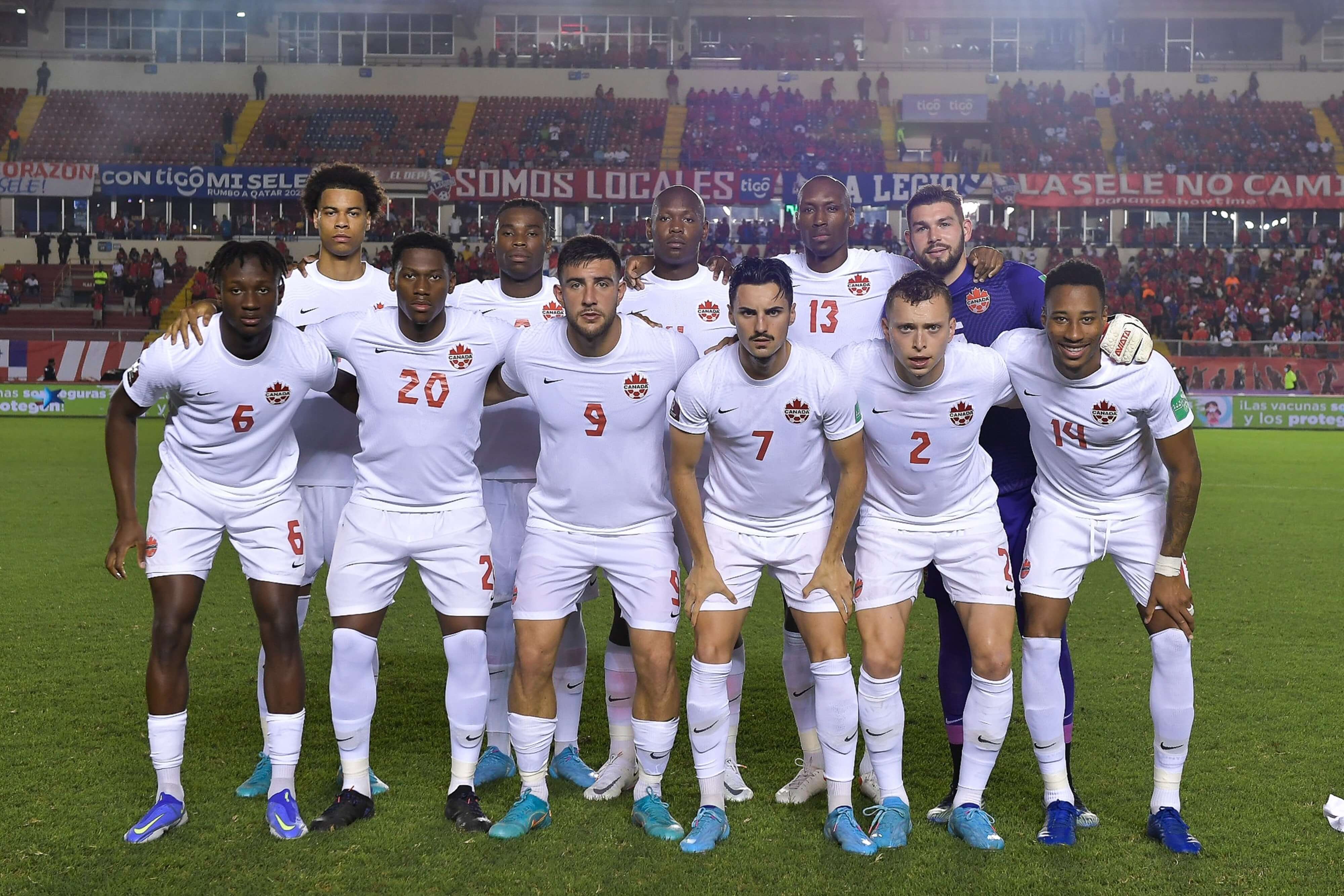 Australia
Australia
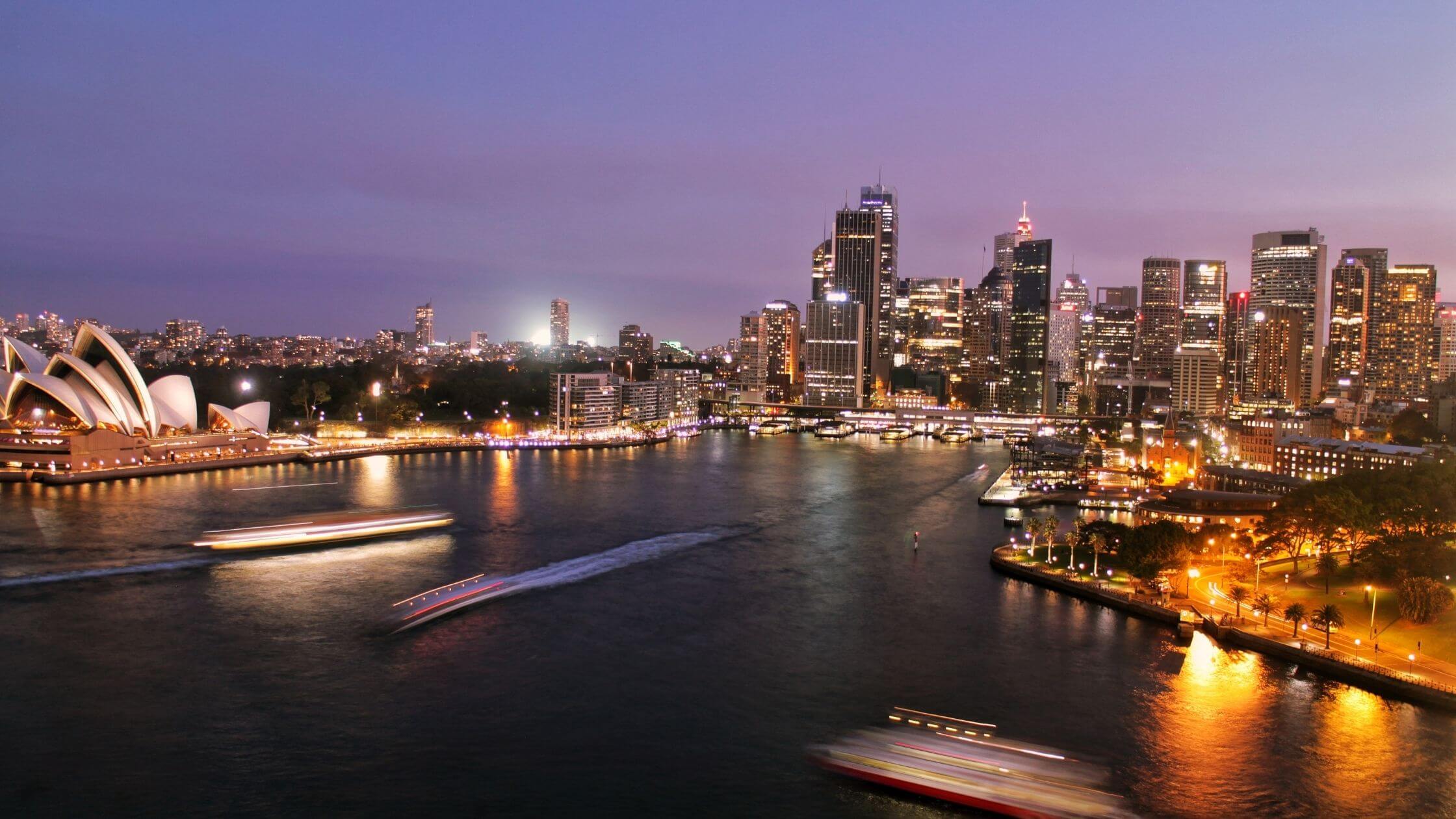
Sydney Opera House. Image: Pexels.
In Australia, statistics show that between 2020-2021, the CPI rose by 3.5%. Specifically, Sydney saw a 3.1% increase in consumer prices, while Brisbane and Melbourne stood at 4.3% and 2.5% respectively. Price increases were mainly driven by dairy and related products which saw a rise of 1.7%, but this was offset by a reduction in prices of fruit by 1.2% due to favorable growing conditions.
A SunCorp report revealed that the average spend per week for groceries for a single individual amounted to $135 (€86.54), or $270 (€173.08) for a couple.
(1€ = AUD$1.56) While this merely scratches the surface of how to manage your retirement income, hopefully, it has shed some light on what the cost of everyday groceries is like in Croatia compared to where you may be living right now.
While this merely scratches the surface of how to manage your retirement income, hopefully, it has shed some light on what the cost of everyday groceries is like in Croatia compared to where you may be living right now.
For more, check out our lifestyle section.
Tomašević: Zagreb Ready to Provide All Assistance to Ukrainian Refugees
February 26, 2022 - Today Interior Minister Davor Božinović announced the beginning of the arrival of Ukrainian refugees in Croatia, following the Russian invasion of their country. The mayor of Zagreb, Tomislav Tomašević shared on his social networks that they will provide all the necessary assistance for them.
Being the third day since the Russian invasion of Ukrainian territory began, neighboring countries begin to receive Ukrainian refugees at their borders. This is the case of Poland, Moldova, Romania, Slovakia, and Hungary, but also that of nearby countries such as Germany and the Czech Republic, all of whom, in addition to expressing their solidarity and condemning the Russian invasion, have confirmed their support in receiving and attending to the refugees. Although Ukraine does not belong to the European Union or the Schengen area, some of these countries maintain border agreements with Ukraine, and others have indicated that they will not require visas or permits to facilitate their entry.
The Croatian Interior Minister Davor Bozinovic stated today that several Ukrainian nationals have already arrived in Croatia and that the groundwork to make them comfortable and provide for their needs is now underway.
The news comes just after Croatian Prime Minister Andrej Plenkovic took to Twitter to tweet that he has spoken with the government and with the Red Cross and that things were now fully underway to accept fleeing Ukrainian refugees.
The mayor of the Croatian capital of Zagreb, Tomislav Tomašević, has been the most recent authority to speak out on the arrival of Ukrainian refugees, and through a post on Facebook, he has expressed his solidarity, and also guaranteed his support and assistance for them.
''The City of Zagreb is ready to provide all possible assistance to refugees from Ukraine. We will make more locations available for the eventual reception of refugees, depending on their needs. This is the least we can do in solidarity with the citizens of Ukraine and the human tragedy they are going through'', reads the post shared by Tomašević.
The mayor of Zagreb finished his post by condemning the Russian invasion in Ukraine: ''I strongly condemn the aggression against Ukraine, because of which many lives will be destroyed - the violence must stop so that the innocent do not continue to suffer''.
For more on the Ukraine crisis and Croatia, as well as breaking news, follow our news section.
Davor Bozinovic: Several Ukrainian Refugees Have Arrived in Croatia
February the 27th, 2022 - Ukrainian refugees have begun to arrive in other countries following Russia's illegal and unjustified invasion of their country. Interior Minister Davor Bozinovic has stated that several Ukrainian nationals have already arrived in Croatia and that the groundwork to make them comfortable and provide for their needs is now underway.
The news comes just after Croatian Prime Minister Andrej Plenkovic took to Twitter to tweet that he has spoken with the government and with the Red Cross and that things were now fully underway to accept fleeing Ukrainian refugees.
''I convened a meeting with members of @VladaRH, Civil Protection and @crvenikriz_hr in order to raise the level of preparedness regarding the reception of refugees from Ukraine due to Russian aggression. We stand in solidarity with the Ukrainian people'' read Plenkovic's tweet.
As N1 Hrvatska writes, Interior Minister Davor Bozinovic has stated that things are moving forward and that those who usually deal with the question of refguees are all involved.
"Everyone who deals with refugee issues was there. We've decided to structure the coordination [of the acceptance of Ukrainian refugees in Croatia] through one government body that will engage with as much intensity as the situation requires of our institutions. We've reviewed the current situation on these issues,'' said Davor Bozinovic, before adding:
"A special council has been convened in Brussels, I will go there and we will consider these issues at the European Union (EU) level, given that the potential is such that more or less all EU member states are likely to be involved in dealing with the increased influx of displaced persons from Ukraine, and all countries have prepared for their reception.
A dozen people from Ukraine entered Croatia who came through private channels, through friendly contacts, and they have been properly accommodated in private accommodation,'' the minister said.
He said Croatia has accommodation facilities to accommodate an influx of Ukrainian refugees as the conflict there escalates even further.
"The point of today's meeting is to simply coordinate the matter," he added.
"We can manage, we're ready, if needed - and I must say that I would not like to rush into it - but yes, we can accommodate people from today onwards," concluded Davor Bozinovic.
For more on the Ukraine crisis and Croatia, as well as breaking news, follow our news section.


